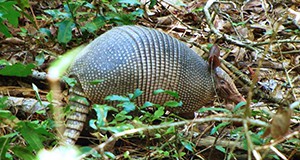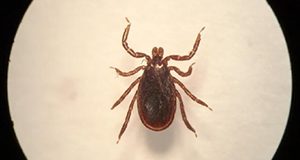Southern tick-associated rash illness (STARI) is a human tick-borne disease that occurs following the bite of Amblyomma americanum, the lone star tick, which is the most common and aggressive human-biting tick in the South, accounting for over 90% of human tick bites in the region. STARI is often described as a “Lyme-like illness” because it causes a rash like the “bulls eye” rash associated with Lyme. Other symptoms of STARI that are similar to symptoms of Lyme disease include headache, fatigue, and muscle and joint pain. Scientists know the tick vector and that some wildlife species play a role in maintaining the disease in nature, but very little else is understood about this mysterious illness. This 4-page fact sheet written by Katherine Sayler, Carisa Boyce, and Samantha Wisely and published by the Department of Wildlife Ecology and Conservation provides the basic facts we do know, the differences between STARI and Lyme disease, plus advice for tick-bite sufferers and strategies to avoid tick bites.
http://edis.ifas.ufl.edu/uw421
Tag: Facts about Wildlife Diseases series
Facts about Wildlife Diseases: Hemorrhagic Fever in White-Tailed Deer
The viruses that cause hemorrhagic disease (HD) in deer do not cause illness in people, but they are a growing problem. HD is the most important viral disease of white-tailed deer in the United States. Large outbreaks have occurred in the northern Midwest and western United States. In Florida outbreaks are fewer and less severe in populations of wild white-tailed deer than are outbreaks among wild deer in other areas of the United States, but farm-raised deer in the state are proving vulnerable to epizootic hemorrhagic disease virus: one of the viruses that cause HD. This 6-page fact sheet written by Katherine A. Sayler, Charlotte Dow, and Samantha M. Wisely and published by the Department of Wildlife Ecology and Conservation describes best management techniques for outbreaks of HD in farm-raised deer. It includes strategies for best supportive care for sick animals, diagnostics, and integrated pest management to control biting midges that spread the viruses that cause HD, because the best way to manage HD is to prevent it.
http://edis.ifas.ufl.edu/uw411
Facts about Wildlife Diseases: Leprosy

Worldwide, 250,000 new cases of leprosy are reported each year, and in the United States, approximately 150 new cases of leprosy are diagnosed each year. Also known as Hansen’s disease, leprosy (Mycobacterium leprae) is a bacterial disease that infects the skin and nerves, causing disfiguring skin sores, nerve damage, and occasionally lung damage if left untreated. Leprosy is spread between humans via respiratory droplets when people sneeze or cough. In the southeast United States, handling armadillos is thought to be the source of many infections. This 4-page fact sheet written by Shannon P. Moore and Samantha M. Wisely and published by the Wildlife Ecology and Conservation Department describes the disease in humans and armadillos and explains how to avoid it and limit its spread.
http://edis.ifas.ufl.edu/uw408

